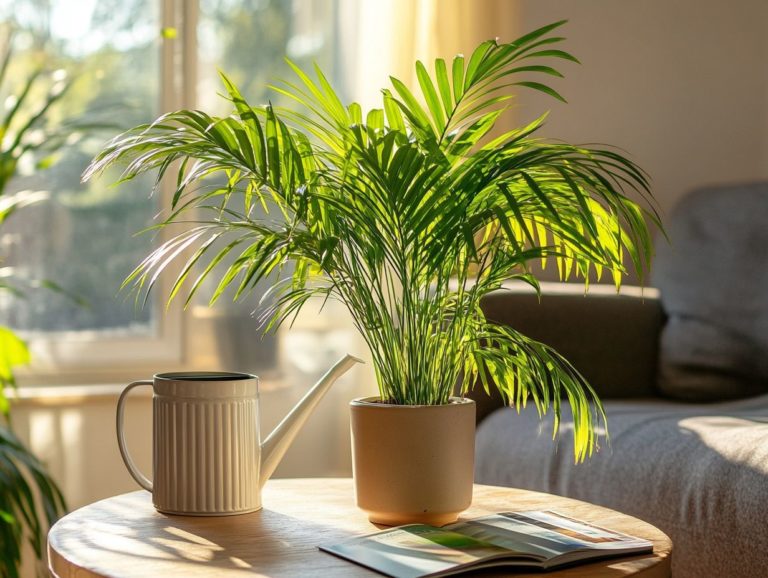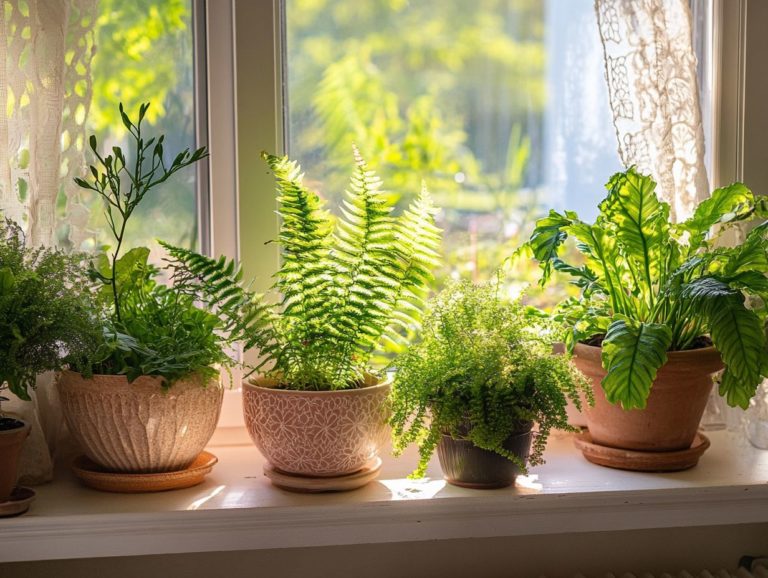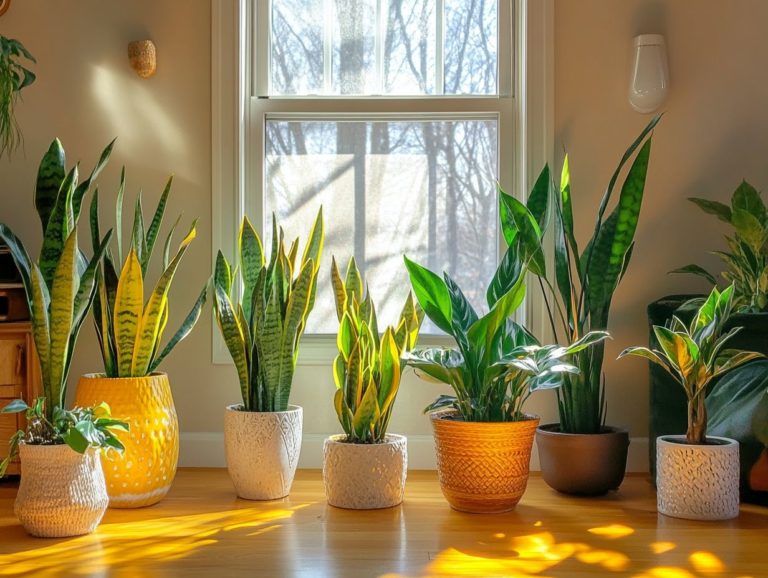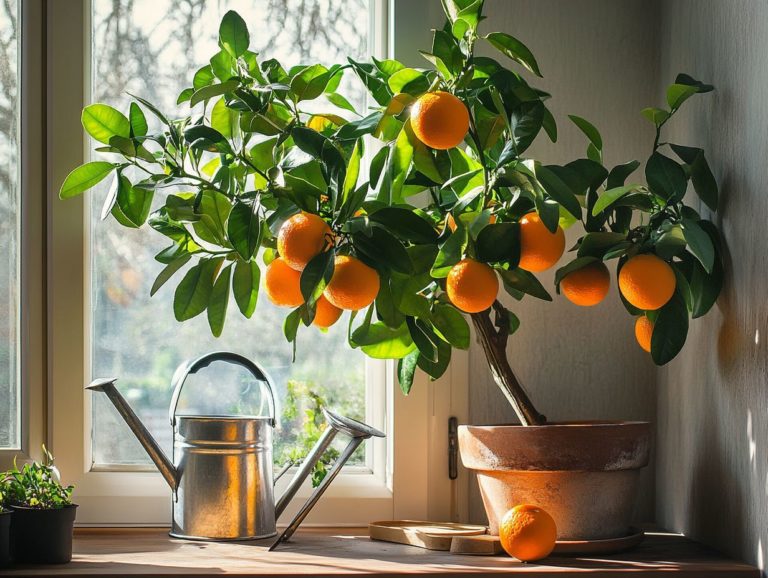Fiddle Leaf Fig: A Complete Care Guide
The Fiddle Leaf Fig has emerged as a beloved choice for both home d cor aficionados and plant enthusiasts.
Its dramatic, oversized leaves and striking architectural shape not only elevate any space but also bring nature indoors.
Get ready to explore everything you need to know about caring for your Fiddle Leaf Fig!
This guide will provide you with all the essentials for selecting the perfect Fiddle Leaf Fig, caring for it confidently, addressing common challenges, and styling it to become a captivating centerpiece in your home.
Immerse yourself in the world of this extraordinary plant and learn how to nurture and display it beautifully!
Contents
Key Takeaways:

- Choose the right fiddle-leaf fig by considering factors such as size, health, and location.
- Provide proper light conditions, water needs, and soil, and regularly trim and grow new plants from cuttings.
- Manage common issues with pest control and disease management, and creatively decorate your home with this trendy plant.
Overview of the Plant and its Characteristics
The fiddle-leaf fig, or Ficus lyrata, is truly a showstopper among indoor plants, hailing from the sun-drenched landscapes of South Africa.
With its large, glossy leaves, this plant has the power to elevate any room’s aesthetic, making it a favorite for those who appreciate the beauty of nature indoors.
As one of the most coveted houseplants, its striking structure and vibrant green foliage not only captivate the eye but also enhance indoor air quality, winning the hearts of plant enthusiasts everywhere.
This care guide will walk you through the essential qualities of the fiddle-leaf fig, ensuring you grasp the key requirements for its growth and maintenance.
Originating from lush tropical rainforests, the fiddle-leaf fig thrives in bright, indirect sunlight, making it a perfect companion for sunny spots near your windows.
Its eye-catching silhouette often becomes the centerpiece of modern decor, harmonizing seamlessly with styles ranging from minimalist to bohemian.
This plant also acts as a natural air purifier, effectively filtering out toxins from your environment.
For those eager to enrich their living spaces, mastering the art of caring for this elegant species including watering techniques and humidity preferences is vital.
By welcoming such healthful indoor plants into your home, you not only enhance your surroundings but also foster a positive impact on your overall well-being.
Choosing the Right Fiddle Leaf Fig
When choosing the ideal fiddle-leaf fig for your home, it’s essential to take into account several factors that affect both the plant’s health and your personal style.
With a plethora of options available at well-known retailers like Home Depot, Lowes, and IKEA, you might find yourself feeling a bit overwhelmed by all the choices.
Grasping the nuances of fig tree care such as the right pot size and soil moisture is critical for ensuring a rewarding and successful plant ownership journey.
Factors to Consider When Purchasing
When you’re on the hunt for a fiddle-leaf fig, there are several key factors to keep in mind to ensure you select a flourishing specimen that aligns with your indoor plant care aspirations.
First and foremost, evaluating the plant’s health is crucial. Look for vibrant leaves that are free from any signs of dropping or discoloration, as these can reveal potential underlying issues.
The choice of a suitable drainage pot and the right potting mix will also play a vital role in the long-term success of your fiddle-leaf fig.
When inspecting the leaves, pay attention to their firmness and glossy finish these are indicators of well-nourished foliage.
Selecting a pot with proper drainage holes will help prevent water accumulation, which is essential for avoiding root rot.
Understanding the soil requirements is equally important; opting for a well-aerated potting mix that retains moisture while draining effectively will support the plant’s growth.
Keep in mind that the fiddle-leaf fig thrives best in bright, indirect light and prefers humidity levels between 30-65%.
Make sure it s in the right spot your Fiddle Leaf Fig will thrive there!
Caring for Your Fiddle Leaf Fig

Caring for your fiddle-leaf fig is vital for its growth. Start by understanding its needs for light, water, and soil.
This indoor plant flourishes in bright light. Adequate exposure is essential.
Establish a simple watering routine that aligns with your fiddle-leaf fig’s needs. This helps you avoid common pitfalls like root rot or leaf drop.
Monitor humidity levels closely to ensure an optimal environment for this tropical beauty. Complement it with the right potting mix.
By paying attention to these details, you ll nurture a thriving plant that enhances your living space.
Light, Water, and Soil Requirements
The health of your fiddle-leaf fig hinges on its light, water, and soil needs. Each plays a crucial role in its growth and vitality.
Providing bright light exposure is essential for photosynthesis. A simple watering routine meets the plant’s hydration requirements without the risk of overwatering, which can lead to dreaded root rot.
Select a soil mix that retains moisture yet allows for proper drainage. This sets the stage for your fiddle-leaf fig to thrive.
Humidity also affects your plant’s health. Fiddle-leaf figs flourish in environments with higher humidity, ideally ranging from 30% to 65%.
Misting the leaves or placing a humidifier nearby can significantly enhance humidity levels. This promotes lush foliage and curbs leaf drop.
Stick to a consistent watering schedule typically every 1-2 weeks, depending on the season to ensure the soil stays adequately moist without becoming waterlogged.
Using a potting mix rich in organic material, such as peat or coconut coir, improves aeration and moisture retention. This ultimately fosters the overall health of this stunning indoor plant.
Pruning and Propagation Techniques
Pruning and propagation of the fiddle-leaf fig are essential techniques that promote robust growth and elevate the aesthetic allure of your indoor space.
Armed with the right pruning shears, you can trim your fiddle-leaf to maintain its shape and encourage a fuller, bushier appearance. Don t forget to keep those lovely leaves dust-free to maximize photosynthesis and overall health.
Propagation means creating new plants from existing ones. It opens up an exciting avenue to expand your plant collection or share the joy of greenery with friends and family.
For the best outcomes, timing is key. Late spring to early summer is the prime window for pruning, while propagation works wonders during the growing season when your plant is most lively.
Techniques like cuttings or air layering are your go-to methods for propagation, ensuring successful root development.
Maintaining high humidity levels and placing the cuttings in bright, indirect light sets the stage for thriving growth.
By following these practices, you can ensure the vigor of your fiddle-leaf fig and its enduring beauty within your living space.
Common Issues and How to Solve Them
Understanding the common challenges that fiddle-leaf figs face like leaf drop or root rot is essential for any discerning plant parent committed to cultivating a vibrant indoor garden.
Implementing simple pest and disease solutions can dramatically lessen the likelihood of these issues. This enables your fiddle-leaf fig to thrive in its surroundings.
Act now to prevent these common issues. By taking a proactive approach to these potential obstacles, you bolster the health of your plant and enrich your experience as a dedicated caretaker.
Pest Control and Disease Management
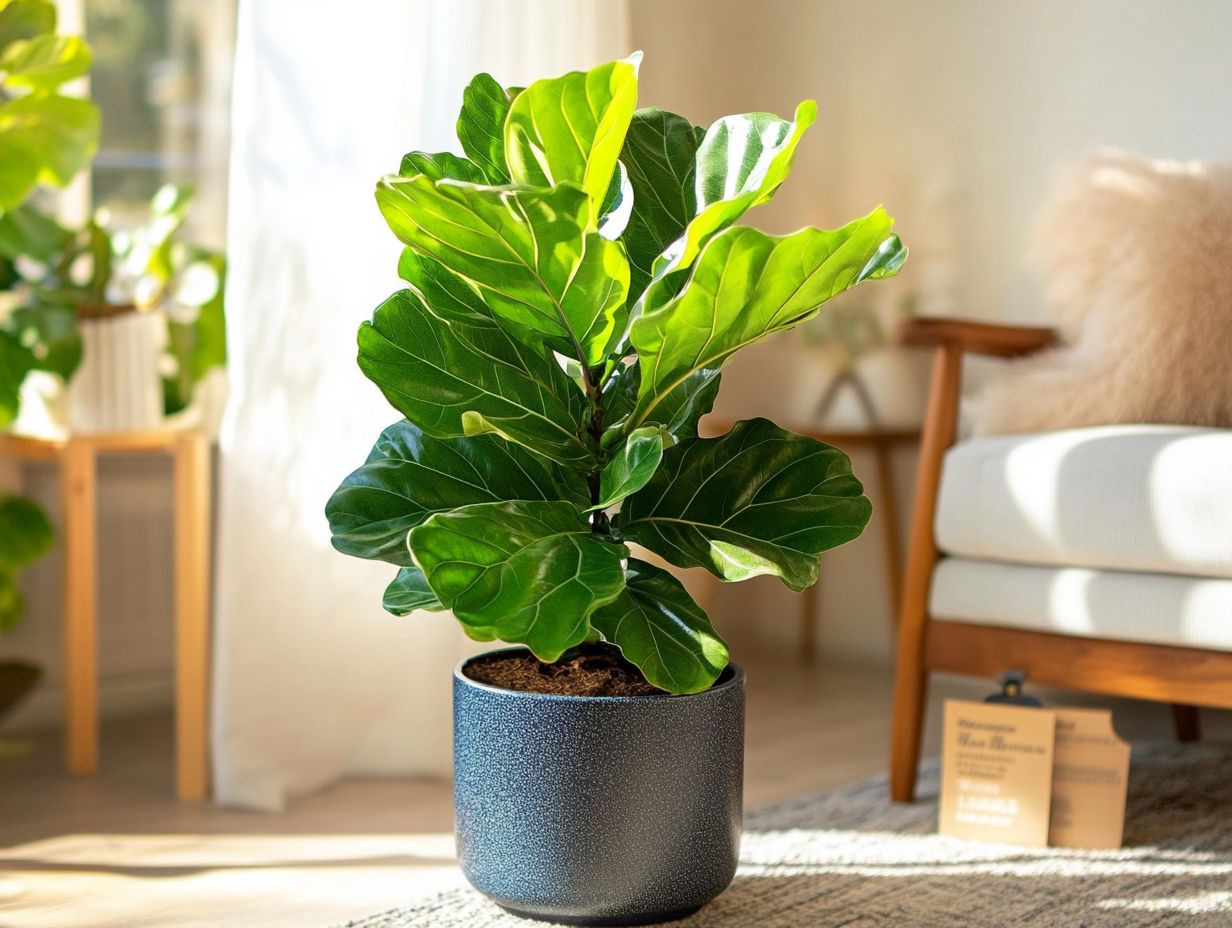
Pest control and disease management are crucial for maintaining a healthy fiddle-leaf fig. These practices help you avoid issues like root rot and ensure optimal growth conditions. By regularly inspecting your plant for signs of pests or diseases, you empower yourself to tackle problems early, minimizing their impact on your fiddle-leaf s health.
One of the most common pitfalls for plant parents is over-watering, which can lead to root rot and other serious complications. Mastering the right watering techniques is vital; achieving the perfect moisture balance is key to your plant s vitality.
Pests such as spider mites and mealybugs can wreak havoc, showing up as discolored leaves or a sticky residue. Spotting these symptoms promptly allows you to spring into action with insecticidal soaps or natural remedies.
Embracing best practices, like maintaining proper humidity levels and ensuring good airflow (the movement of air around the plant), can further prevent pest infestations. Monitoring soil moisture and using well-draining pots are effective strategies to safeguard against root rot, creating a thriving environment for your fiddle-leaf fig.
Decorating with Fiddle Leaf Figs
Decorating with fiddle-leaf figs can truly elevate the aesthetic of any room in your home. Their striking foliage delivers a bold visual impact that harmonizes beautifully with various interior styles.
Whether you position your fiddle-leaf fig in a sun-drenched corner or feature it as a statement piece in your living area, thoughtful placement that considers its light conditions can significantly enhance the overall ambiance.
Considering the light and humidity requirements, along with the fiddle-leaf’s specific water needs, ensures that your plant not only looks exquisite but also thrives in its chosen spot.
Tips for Styling and Placement in Your Home
When styling and placing your fiddle-leaf fig in your home, several key tips can help you maximize both its visual appeal and health.
First, consider the light exposure in your chosen location; these plants thrive in bright light conditions. Strategically positioning your fiddle-leaf fig to complement your existing decor will create a harmonious space. To ensure optimal growth, you can also learn how to propagate fiddle leaf fig trees. Keep it away from air vents to maintain stable humidity levels, which are crucial for the overall well-being of your indoor plant.
Monitoring humidity in the room is essential. These tropical beauties flourish in moisture-rich environments. Positioning your fiddle-leaf fig near a humidifier or grouping it with other plants can create a microclimate that supports its growth.
Opt for decorative pots that align with your home s aesthetic to enhance its presence. Don t forget to rotate the plant occasionally to ensure even growth and prevent it from leaning toward the light. Paying attention to these environmental factors boosts the plant’s vitality and elevates your interior decor.
Frequently Asked Questions
What is a Fiddle Leaf Fig?

Also referred to as the fig tree, a Fiddle Leaf Fig is a popular houseplant known for its large, glossy, violin-shaped leaves. It is native to western Africa and is commonly used as a decorative plant in homes and offices.
Caring for Your Fiddle Leaf Fig
To take care of a Fiddle Leaf Fig, place it in a well-lit spot with indirect sunlight. Water it regularly but not too frequently, and dust its leaves to keep them clean and healthy. It is also important to fertilize the plant every 2-3 months.
Why are the leaves on my Fiddle Leaf Fig turning brown?
Brown leaves on a Fiddle Leaf Fig can be caused by over or under-watering, low humidity, or lack of nutrients. Check the soil moisture and humidity levels, and adjust your watering and fertilizing schedule accordingly.
Can I propagate my Fiddle Leaf Fig?
Yes, you can propagate a Fiddle Leaf Fig by taking stem cuttings and rooting them in water or soil. Keep the cuttings in a warm, humid environment and water them regularly until they develop roots.
Ready to enhance your space with a fiddle-leaf fig? Start shopping for your plant today!
How often should I repot my Fiddle Leaf Fig?
Repot your Fiddle Leaf Fig every 1-2 years or when the roots outgrow the pot. Choose a pot that is 2-4 inches larger in diameter.
Use well-draining potting soil. This helps promote healthy growth.
What should I do if my Fiddle Leaf Fig is not growing?
Is your Fiddle Leaf Fig struggling to grow? It might be due to low light, improper watering, or not enough nutrients.
Place it in a brighter spot, water it correctly, and fertilize regularly to encourage growth.

